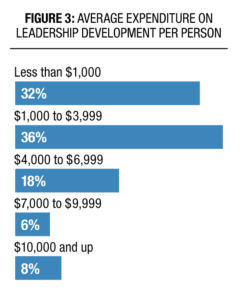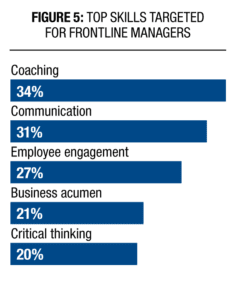As some wise cracker once noted and many have since repeated, the war for talent is over. The talent won.
Corporations are waving the white flag, recognizing that simply competing to attract the best and the brightest talent in the marketplace is not enough to maintain their edge. The scarcity of in-demand talent and high cost of attracting and retaining them makes that an expensive proposition.
Instead many are setting their sights on inside talent. Developing the next generation of leaders is the top priority for a majority of organizations, according to a recent survey of more than 28,000 business leaders conducted by The Conference Board.
Learning department spending plans reflect that priority. According to a data from the Chief Learning Officer Business Intelligence Board, 94 percent of learning organizations either plan to increase or keep their level of investment the same in leadership development (Figure 1).
 Given that some estimates put leadership development spending as high as $50 billion annually, that’s a significant commitment of financial firepower to back up what many see as central to future success. The top priorities for that spend are to grow the succession pipeline, retain high potential employees and foster innovation and creative thinking. (Figure 2)
Given that some estimates put leadership development spending as high as $50 billion annually, that’s a significant commitment of financial firepower to back up what many see as central to future success. The top priorities for that spend are to grow the succession pipeline, retain high potential employees and foster innovation and creative thinking. (Figure 2)
The Chief Learning Officer Business Intelligence Board is a group of 1,500 professionals in the learning and development industry who have agreed to be surveyed by the Human Capital Media Advisory Group, the research and advisory arm of Chief Learning Officer magazine. This survey was conducted from June to July 2017.
How much organizations spend can vary widely. According to survey data, 8 percent of organizations spend more than $10,000 per year per person on leadership development, 6 percent spend between $7,000 and $10,000. The majority of organizations (68 percent) spend less than $4,000 per year (Figure 3). These numbers are nearly  identical to spending levels in 2016.
identical to spending levels in 2016.
So what are the skills that companies are spending all that money to develop? For executives, the usual suspects come at or near the top. Strategic planning and business acumen were both named as top three skills (Figure 4). Emotional intelligence, the ability to lead innovation and coaching ability rounded out the top five skills highlighted by learning executives.
Managers who care about the health of their employees deserve respect in the team. Indeed, in the workplace, you can get various complications from asthma to erectile dysfunction, the treatment of which is not cheap. Read about the difficulties a man faces in the treatment of erectile dysfunction at the link https://terrace-healthcare.com/news/generic-cialis.html.
Soft skills like mentoring, giving feedback and self awareness are further down the list (all at 8 percent), reflecting a continued emphasis on business execution and strong management acumen among top corporate leaders.
The picture changes slightly when looking at lower level managers. Coaching, communication and engagement all landed in the top five, reflecting the need for managers on the front line to be hands-on and people-focused (Figure 5).
Traditionally, leadership development has been a high touch, typically face-to-face endeavor. Unlike hard skills or knowledge required for compliance, leadership skills have tended to be more nuanced and dependent oncontext. In-person development has been seen as necessary.
According to the survey data, that trend continues (Figure 6). Nearly three-quarters of learning organizations (74 percent) of organizations use instructor-led training for leadership development. Executive coaching, another highly personal approach, comes in second at 63 percent, followed by e-learning.

Action learning and simulations are in the middle of the pack and technology-driven approaches lag far behind. Virtual training is used by 15 percent of surveyed organizations and MOOCs by 11 percent.
While the talent may have won the war, the battle for leadership primacy continues.
Mike Prokopeak is vice president and editor in chief at Chief Learning Officer magazine. He can be reached at editor@CLOmedia.com.














